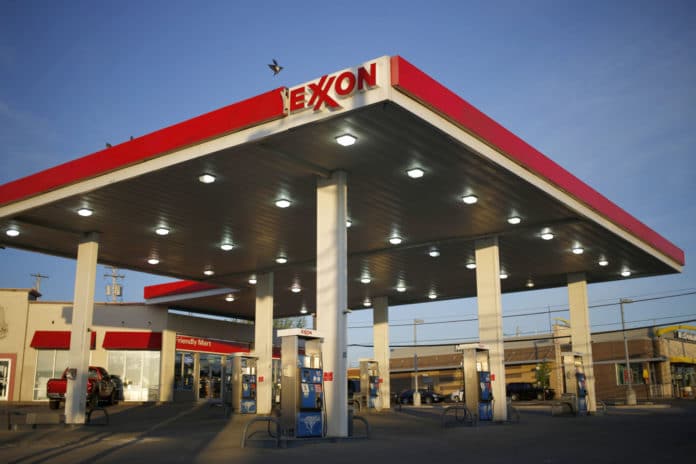When it comes to natural gas, Exxon Mobil believes in playing the long game.
As competitors continue to flood the world market with a liquefied form of the fuel, depressing prices, Exxon is heeding the advice of forecasters scanning a quarter-century beyond the current glut. Their view: LNG demand will rise 1.6 percent a year through 2040, more than double the rate for crude oil.
With much of that growth set to come from the Asia-Pacific region, the world’s biggest energy producer is working to bookend the area with resources, pursuing promising but as-yet untapped natural gas fields in Papua New Guinea and Mozambique that won’t produce for years. It’s a strategy that stands in stark contrast to Royal Dutch Shell’s takeover of BG Group, an established producer that promises to quickly swell Shell’s LNG exports, even as prices remain low.
“Exxon has a different strategy in that it’s not looking to grow its gas business right now but is looking at what will happen in LNG 10 or 15 years from now,” said Brian Hennessey, who manages $1.3 billion at Alpine Woods Capital Investors. “The market’s going to get tight starting in 2020.”
The influx of LNG from gigantic projects first conceived a decade ago has swamped markets with excess supply, dropping the average worldwide price by 37 percent last year to $9.77 per million British thermal units, according to the International Gas Union. In Japan, the world’s biggest LNG market, the price of cargoes from Qatar tumbled 70 percent in two years to $4.93 per million Btu. Spot LNG in Singapore fell 1.3 percent on Thursday to $5.187 per million British thermal units, according to Singapore Exchange Ltd.
But the glut may be short-lived as low prices spur new buyers to enter the market and the advent of low-cost import facilities enables poorer nations to receive cargoes.
Exxon spokesman Scott Silvestri referred to Vice President Jeff Woodbury’s remarks on long-term gas demand during a July conference call.
“Like any type of commodity,” Woodbury said, “there are going to be periods of oversupply and periods of shortness, and we do expect that into the early part of the next decade that there will be some oversupply. But we keep focused on the long-term value proposition.”
While internal projections used by Exxon to guide their investments show a clear picture of rising demand, forecasters at the U.S. Energy Information Administration are even more bullish. They predict demand will rise an average 1.9 percent annually through 2040.
That “tidal wave” of demand will overwhelm available supplies and pit major importing nations in a bidding war for LNG cargoes as soon as the early 2020s, said Fred Beach, assistant director for policy studies at the University of Texas Energy Institute, in a telephone interview.
“Consensus is that the LNG market will be over-supplied for the next 5+ years,” wrote Anish Kapadia, managing director at Tudor Pickering Holt & Co. in London, in a note to clients on Wednesday. “However, there is the potential for the market to tighten around the end of the decade as we see downside risks to supply and upside risks to demand.”
In July, Exxon agreed to pay between $2.3 billion and $3.6 billion for InterOil Corp.’s Papua New Guinea finds, and is in talks to buy stakes in the fields in Mozambique. The final value of the stock-and-cash agreement with InterOil, expected to close within weeks, depends on how large the natural gas reserves prove to be.
More drilling is required to figure that out, as well as the optimal locations for production wells that can eventually produce natural gas for export. The Mozambique assets are in a similar state of nascent development.
The InterOil transaction will be Exxon’s biggest acquisition since a 2009-2013 spree in which the company acquired multiple North American gas drillers, including the $35 billion buyout of XTO Energy Inc. That foray has yet to pay off.
In the six years since the XTO transaction closed, U.S. gas prices have fallen 40 percent. Within 24 months of the biggest deal of his career, Exxon Chairman and Chief Executive Officer Rex Tillerson told a Council on Foreign Relations gathering that he and fellow gas producers were “all losing our shirts.”
Although Tillerson sold the XTO deal as a way to bring shale-drilling expertise into Exxon, the transaction loaded the company with massive amounts of gas production just when prices were in retreat. Every year since then, the company has cut U.S. gas production, reducing output by 20 percent in the past half decade.
Exxon’s long-term approach has also meant slamming the brakes on projects that are moving too fast.
Last week, the company told Alaska lawmakers it’s quitting an LNG project in that state because its leaders want Exxon and its partners, BP and ConocoPhillips, to spend money on engineering and design work even though a fiscal agreement for the development hasn’t been finalized. Bill McMahon, Exxon’s senior commercial adviser on the project, told an Alaskan legislative panel on Aug. 25 that the company will hand control of the project to the state by the end of the year.
Tillerson’s new LNG strategy included a meeting with Mozambique President Filipe Nyusi in the capital city of Maputo in July to discuss acquiring a stake in Eni SpA’s offshore gas holdings, according to a person with knowledge of the talks. Exxon is also talking to Anadarko Petroleum Corp. about buying into a nearby discovery beneath a part of the seafloor known as the Rovuma Basin.
Exxon’s newest push is definitely “a long gas play,” said Thomas McNulty, an analyst at Navigant Consulting in Houston. “Even though demand has weakened in markets like China, Japan and South Korea in the near term, the long-term view is that demand will recover and be strong in that part of the world.”
—
Contributors: Paul Burkhardt, Dinesh Nair and Christine Buurma.






